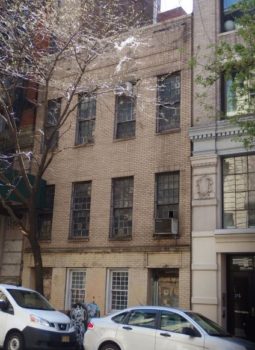
The former Colored School No. 4 retains its original form and configuration, and windows on the second and third floor. Image Credit: LPC.
On February 14, 2023, the Landmarks Preservation Commission voted to calendar the former Colored School No. 4 as an individual landmark. The former school, located at 128 West 17th Street in Chelsea, Manhattan, is the only surviving school building that exclusively served African American students in Manhattan in the second half of the 19th century. The building serves as a significant reminder of racially segregated education in New York City, and the accomplishments of notable figures associated with the school.
The three-story building was constructed in 1849-1850 by the New York City Public School Society. The building’s design follows the Model Primary School House plan, with a 25-foot wide four-bay facade, large multi-pane windows, and two entrances for boys and girls on the first level. The school, built like a row house, was built to accommodate approximately 300 students aged five to seven. The first story served as an indoor play area and wood storage. Students sat in long rows parallel to the sides of the building, with girls on the second floor and boys on the third.
In 1853, when the Board of Education was established, the building was transferred to the City of New York. The school was known as “Colored School No.7” starting in 1860 and “Colored School No. 4” in 1866. At this time, eight primary schools served almost 2,400 African American students in Manhattan. The Board of Education dropped the term “Colored” from schools in 1884, and the school became Grammar School No. 81. The school continued to exclusively serve African American students until 1894, when the segregated schools were closed.
The school is also associated with several notable teachers and students. Sarah J.S. (Tompkins) Garnet, the school’s principal, was one of the first African American women to serve as a principal in New York City public schools. She was also a suffragist and activist. She helped establish the Equal Suffrage League of Brooklyn. During the New York Draft Riots in July 1863, Garnet and her staff stopped rioters from storming the school building, protecting the children.
Other notable figures associated with the school include Joan Imogen Howard, a teacher, who became a manager at the 1893 Columbian Exposition in Chicago. Classical violinist Walter F. Craig and Susan Elizabeth Frazier, who became the first African American teacher at an integrated school in New York City, were both students at the former Colored School No. 4.
The almost 175 year-old building has some alterations but maintains the pre-Civil War urban schoolhouse design. The facade was reclad with beige brick in the 1930s and doors and windows were replaced on the first floor, but the building maintains its form and configuration.
Another remaining school building, the former Colored School No. 3, is the only one in Brooklyn, and was designated a landmark in 1998. Landmarks staff noted that the post-Reconstruction era of African American history in New York City is important but “less well represented” by currently designated landmarks.
While the building no longer serves as a school, it is still the property of the City, now through the Department of Sanitation, which has used the building since 1936.
Landmarks unanimously voted to calendar the former Colored School No. 4. A public hearing will be held at a later date.
By: Veronica Rose (Veronica is the CityLaw fellow and a New York Law School graduate, Class of 2018.)

